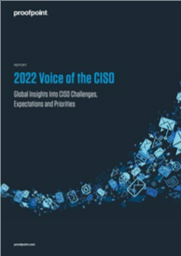2022 Voice of the CISO
Though less eventful than its predecessor, 2021 was another blockbuster year for cybersecurity. With 2020's scramble to enable remote working fading from memory, securing hybrid setups in the long term presented a new and complex challenge.
At the same time, cybercrime went prime time. High-profile cyber-attacks on healthcare, food and fuel supplies put CISOs on high alert. Keeping threat actors out was only part of the problem. Post-pandemic, The Great Resignation saw employees leave their roles in record numbers, often taking valuable data and credentials with them.
To find out how security professionals adapted to this turbulent time, Proofpoint surveyed 1,400 CISOs from around the world, inviting them to share their experiences of the past 12 months and offer their insights for the years ahead.
In the '2022 Voice of the CISO Report,' you'll learn about:
Read More
By submitting this form you agree to Proofpoint contacting you with marketing-related emails or by telephone. You may unsubscribe at any time. Proofpoint web sites and communications are subject to their Privacy Notice.
By requesting this resource you agree to our terms of use. All data is protected by our Privacy Notice. If you have any further questions please email dataprotection@techpublishhub.com
Related Categories: Backups, Cloud, Compliance, Email, ERP, IT Security, Malware, Network, Security Solutions, Service Providers, Software, Telecommunications


More resources from Proofpoint

Frost and Sullivan Insight Report: Building a...
Most security leaders know that insider threats are serious and evolving cybersecurity risk. But many struggle with communicating those risks to ot...

An Overview of Insider Threat Management
As organistions move towards a more distributed workforce, the traditional perimeter of the office network is long gone. Changes in workforce dynam...

2021 Voice Of The CISO Report
There's no question that 2020 was a challenging year. The pandemic placed an enormous strain on the global economy, and cyber criminals took advant...